#la Tène art
Text
My latest tattoo work:
Triskelion with La Tène Celtic ornamentation and a fine knotwork band. A devotional piece for three beloved gods. A joy to work on this piece - thank you for trusting me and for traveling all the way out to California to be tattooed. 🖤
Made at Ritual Tattoo in Berkeley.
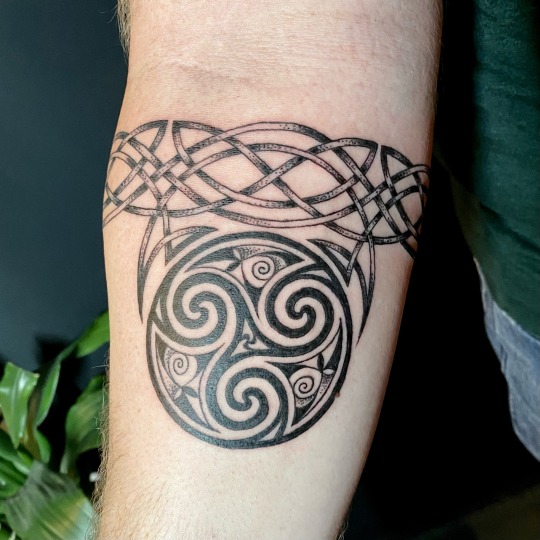
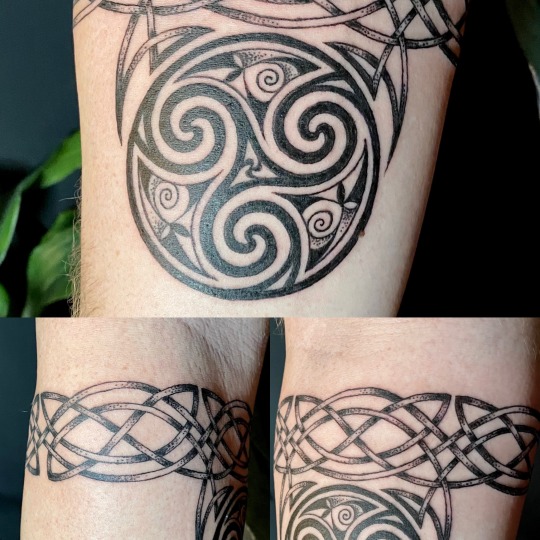
1 note
·
View note
Text

La Tène style design by Aleck Fagan
#La Tène style#pagan#witch#nature#design#pagan witch#the goddess#the horned god#moon#sun#celtic polytheism#celtic witch#celtic style#celtic paganism#celtic art#celtic#irish art#irish heritage#irish history#ancient ireland#concentric#iconography#druidism#pagan druid#druid#sigils
3 notes
·
View notes
Text
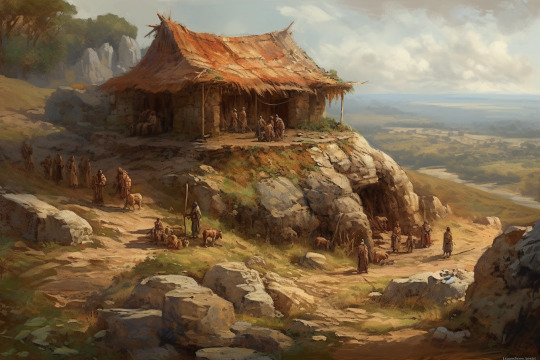
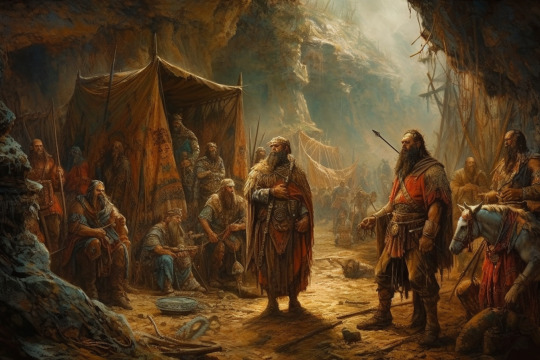
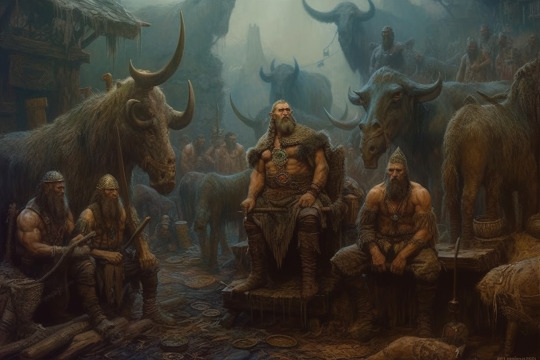
I directed Midjourney to make pictures of the the Yamnaya Culture (first image) and the La Tène Culture (second and third) with a good deal of fantastic latitude. Those cows … wow.
by Midjourney v5
3 notes
·
View notes
Text

I did not expect an iron-age Celtic helmet that looks like a ball cap 🧢
It is called the Meyrick Helmet and has La Tène style decorations.
“La Tène style is "a highly stylised curvilinear art based mainly on classical vegetable and foliage motifs such as leafy palmette forms, vines, tendrils and lotus flowers together with spirals, S-scrolls, lyre and trumpet shapes"
Wikipedia
4 notes
·
View notes
Note
Idk if anyone's mentioned but is the 666 tattoo a reference to white supremacist-style triskelion? Is it, like, a reclaimation of it?
It is a reference to the triskelion, yes, but not in a white supremacist fashion, no, dear Lord! I've just always been very interested in paganism and folklore. It was a wildly used motif in the art of the Iron Age Celtic La Tène culture, especially, but it can be traced back to the European Neolithic and Bronze ages. No white supremacy here whatsoever, fear not!
ETA: Plus, here in France, the triskelion is often used by Bretons as a symbol of their region (Breizh). You see it everywhere, from bumper stickers to logos on menus in a lot of creperies.
1 note
·
View note
Photo

The beautiful Asby Scar sword, a bronze-hilted sword with an iron blade and bronze scabbard belonging to the so called “La Tène” culture,
OaL: 23.1 in/58.8 cm
Width: 1.3 in/3.2 cm
Weight: 2.5 lbs/1145.7 g
recovered from the Asby Scar in Cumbria, England, dated to the 1st century, housed at the British Museum.
#weapons#sword#bronze#iron#enamel#europe#european#british#britain#england#english#cumbria#asby scar#la tène#british museum#art#history
295 notes
·
View notes
Text
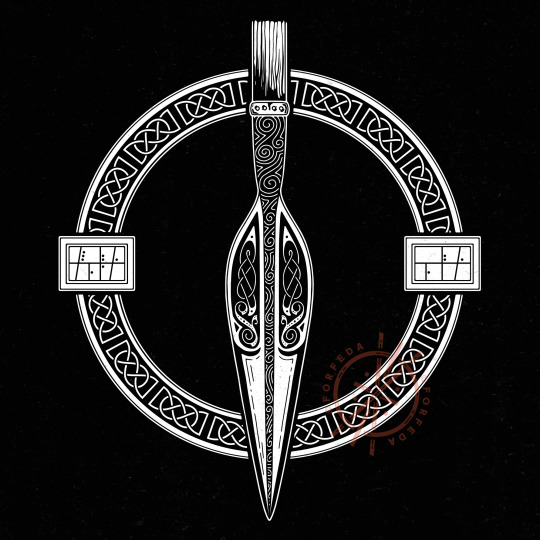
SLEG LUG
"Out of Gorias was brought the Spear that Lug had. No battle was ever won against it or him who held it in his hand."
The youthful Lugh Mac Ethlinn was a king and warrior of the Tuatha Dé, renown for his great skill in all manner of disciplines, which earned him the epithet Samildánach (master of every art). Among his many powerful artifacts, Lugh was said to possess a deadly magical spear that made him undefeatable in battle.
Based on historical Bronze Age Irish spearheads, this design features three major art styles found in Ireland: Neolithic spirals, Iron Age La Tène motifs, and Medieval knotwork. The name "Sleg Lug" is written in Brecor Beo, a variant of the ogham alphabet from the Book of Ballymote.
Part 2/4 of my Four Treasures series.
#celtic#celtic art#mythology#irish mythology#celtic mythology#folklore#ireland#sleg lug#lugh#lámhfada#spear#four treasures#tuatha de danann#celtic knot#knotwork#pagan#pagan art#gaelpol#artists on tumblr#forfedaproject
247 notes
·
View notes
Text


The Wandsworth Shield 2nd C. BCE. The British Museum.
"The Wandsworth Shield is a circular bronze Iron Age shield boss or mount decorated in La Tène style which was found in the River Thames at Wandsworth in London sometime before 1849. Another incomplete bronze shield mount, sometimes called the Wandsworth Mask Shield was found at the same time. Both shield mounts are now held at the British Museum. The bold repoussé decoration on the Wandsworth Shield, comprising two birds with outstretched wings and long trailing tail feathers, has led Barry Cunliffe, Emeritus Professor of European Archaeology at the University of Oxford, to consider the shield to be "among the masterpieces of British Celtic art"
The circular bronze shield mount, another incomplete bronze shield mount, a bronze sword, and celt were found in the River Thames at Wandsworth during dredging operations in 1849 or earlier, and were presented to the Royal Archaeological Institute by William English in December 1849. English was a millwright who operated steam dredging machines on the Thames from 1808 until about 1850. The two shield mounts were donated to the British Museum by the Royal Archaeological Institute in 1858.
The circular shield mount (Proto-Celtic *skētos (compare Breton skoed “shield”; Latin scūtum) comprises a central shield boss and an outer flange, 33 cm in diameter, and may be the central boss of an oblong shield similar to the Battersea Shield. The boss is ornamented with a curvilinear decoration in La Tène style comprising two almost identical bird patterns. There is a depression in the centre of the boss that would have originally held an ornamental stud made of enamel, as is also the case with the Battersea Shield. The surrounding flange is decorated with stylised designs of two large birds, with outstretched palmette wings and long trailing tail feathers, each a mirror image of the other. Further bird shapes are incised with a rocked graver technique on the wings of the two birds. The eye of each bird is marked with a depression in which there is a rivet that would originally have held a stud, possibly of Mediterranean coral. The bronze part of the shield would have been mounted on a wooden backing by six rivets, of which only one survives. This rivet extends 8 mm in length, indicating that the wooden backing to the shield would have been no more than 8 mm thick.
The incomplete bronze shield mount consists of a central boss, 11.85 cm in diameter, which transforms into a half-cylindrical spine at the top and bottom, one end broken and one end terminating in an anthropomorphic face. The surviving portion of the mount is 37.0 cm in length, and is similar to the boss and medial spine on the Witham Shield. The central boss is ornamented with repoussé work combined with a finely engraved spiral decoration, showing the heads of two ducks. The terminal face has three hairspring spirals engraved on the nose, and a row of triangles representing the teeth of the mouth. The surviving bronze mount would have been mounted on an oblong wooden shield with at least seven rivets. The length of the rivets indicates that the wooden backing would have been no more than 8 mm thick.
The circular shield mount is dated to the 2nd century BC, and the mask shield is dated to the later 3rd century BC. It has been conjectured that these two shields, as well as other Iron Age shields that have been found in rivers, such as the Battersea Shield and the Witham Shield, were votive offerings to the Gods. Together with the Witham Shield, the style, especially of the engraving, is very close to that of the Torrs Pony-cap and Horns found in Scotland and now in the Museum of Scotland."
-taken from Wikipedia
https://paganimagevault.blogspot.com/2020/05/the-wandsworth-shield-2nd-c-bce.html
#shield#celtic#ancient celts#celts#europe#pagan#england#paganism#antiquities#london#archaeology#history#ancient history#european art#museums#2nd century bce#the british museum
21 notes
·
View notes
Text
‘Celtic’ art
Celtic knotwork is beautiful, its an aesthetic I am 100% here for, but interestingly its not ‘celtic’ at all. Well not in an archaeological sense. Iron Age art work is far more abstract, with beautiful loops and swirls.
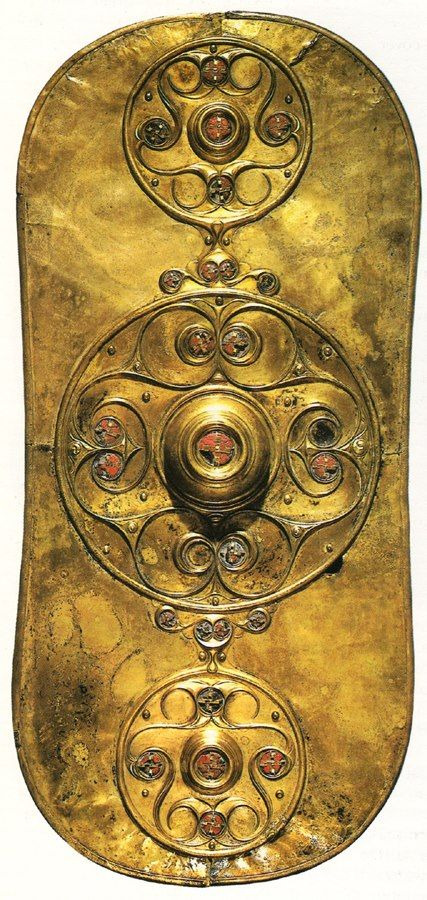
This is the Battersea Shield, dated to middle-late Iron Age. Lots more pretty pictures under the cut.
This style is known as La Tène, and it was prominent in France and Southern Britain in the Iron Age. Here are some other lovely examples of La Tène metalwork

This is a mid-late Iron Age shield boss, also from London. The design is often interpreted as birds.
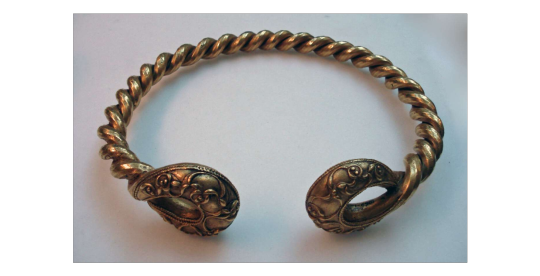
Late Iron Age Torc from Ipswitch. Look at the patterns on the ends, its almost hypnotic.
You know what does look like ‘Celtic’ knotwork? Anglo Saxon and Early Medieval art. Its about 5 centuries after the end of the Iron Age in England
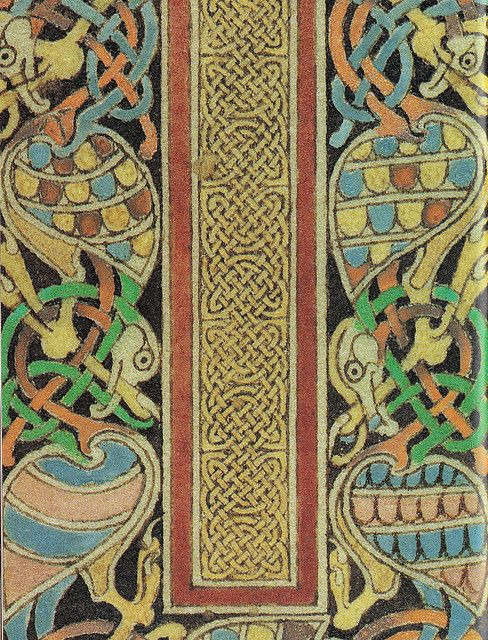
This is a page from the Lindisfarne Gospels, dated to c. 700 AD. Much more what the lay person thinks of as Celtic right?

This is an Anglo Saxon Brooch from the Pentney Hoard (Norfolk) dated to 800-840 AD. Look at the scrollwork on the edges. Classic knotwork pattern.
I’m not sure how the styles ended up being so mixed up in the vernacular, but I’m inclined to blame the Victorians, as well as the general confusion about the word ‘Celtic’.
#Archaeology#Archeology#Iron Age#British Archaeology#History#Celtic#Celtic Art#Celtic knotwork#Iron Age art#La tene#British History#ancient britain#iron age england#celtic england#anglo saxon art#SexandSunworship#Art history
368 notes
·
View notes
Quote
La Tène style is a highly stylised curvilinear art based mainly on classical vegetable and foliage motifs such as leafy palmette forms, vines, tendrils and lotus flowers together with spirals, S-scrolls, lyre and trumpet shapes.
Raghnall O'Floinn, “Treasures of the National Museum of Ireland: Irish Antiquities“
#celtic#celts#art#la tene#style#celtic art#quotes#excerpts#fragment#research#articles#tattoo inspo#x
149 notes
·
View notes
Text


Stop! Bodhmall time! I’m getting the hang of the Celtic ‘vegetal’ (La Tène) organic style frame layouts a bit more now. That’ll be the inking on page 5 of the ‘GN’ done.
(Just realised these are kinda boring photos, I guess I’m thinking about showing off the art more than the camerawork. I’ll have to make that a bit more interesting...)
About the progress thing... I ink backwards... Start from the bottom right corner and work your work back towards the top left. It's a habit I picked up from when I used to ink with thin fountain pens, if you started at frame 1, by the time you got to the end of the page, the natural oils in your skin that've made their way into the page mean the ink doesn't take so well. It's not so much of a problem with the luvverly, big brushpens I use these days, thankfully, but old habits, etc.
#mythology#celtic mythology#comic#fenian#myths#fionn#graphic novel#illustration#myth#brushpen#irish#irish myths#irish mythology#fionn mac cumhaill#comics#comic page#art#original art#folklore#folk tales#celtic#celtic art#bodhmall#liath luachra#fenian cycle#artwork#page layout#wip#progress
9 notes
·
View notes
Text
The Book of Kells: An Immortal Cultural Heritage of the Gaels
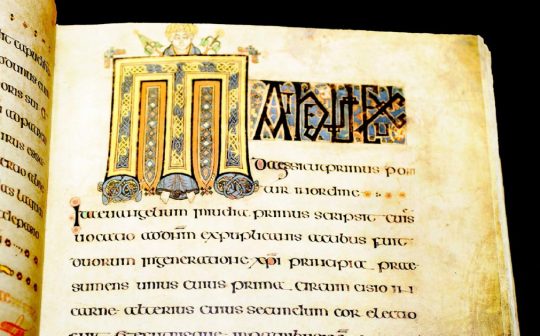
Over the centuries, from its earliest beginnings, Christianity was the inspiration for some truly stunning art. From early frescoes, to illuminated manuscripts , magnificent churches and abbeys, Christian art knew no bounds. And one such piece of art is the iconic and famed Book of Kells.
A historic heritage of early Christianity in Ireland, this magnificently illustrated gospel book is a clear glimpse into the unique art style and identity of the Gaelic peoples. Adorned with intricate details and a dazzling array of colors, this manuscript really shows the result of Christian tradition mixing with the art of the Gaels. And the result is truly stunning.
Dating from the 9th century AD, the manuscript luckily survived to the present day largely unscathed, and it withstood the wheel of time. Today we are bringing you the history of this marvelous art piece and getting you closer to the origins of Christianity in Ireland and the identity of the Gaelic nations. Join us!
Born From the Spirit: The Early Origins of the Book of Kells
When we consider early Christian art and illuminated gospels, there is hardly anyone who has not heard about the famed Book of Kells. Its reputation precedes it, and rightly so, as this is, to date, one of the finest and intricate pieces of illuminated gospels that we know of today. It is also the chief representation of the so called insular art style, and also its culmination.
Insular art refers to the unique form of art that originated on the islands of Ireland and Britain, and its name comes from Latin insula (island). Also known as Hiberno Saxon art, it flourished from 6th to 9th century AD. It is characterized by iconic features of Irish art which is today a chief part of Celtic Christianity, and its main features are truly stunning and complex knotwork interlace designs, La Tène Celtic art elements such as spirals, triskelions, knots, and symbols, Saxon animal motifs, and so on.
All of these elements of insular art are perfectly combined in the Book of Kells, making it a crowning representative of the style.
The exact origin and creation period of the Book of Kells is still largely debated, with several main versions existing. On the basis of the fully developed insular art style that encompasses all the features from the previous centuries, most scholars place the Book of Kells into the 9th century.
Now, the gospel itself is often brought into connection with Saint Columba, as being created by Columban monks, i.e. his followers. Saint Columba (orig. Irish - Colm Cille - “church dove”) died long before the 9th century, in 597 AD. He was an Irish missionary who is credited with successfully spreading Christianity among pagan Gaels and the Picts.
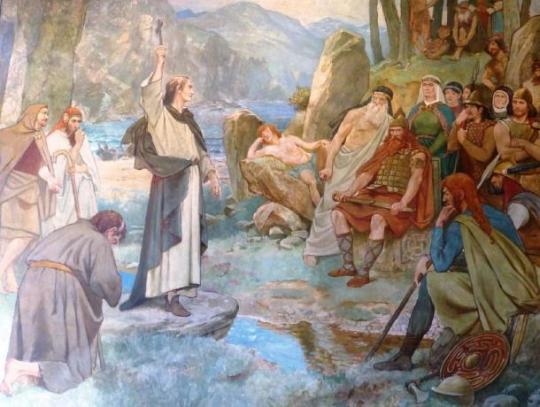
Saint Columba converting King Brude of the Picts to Christianity. (Kim Traynor / CC BY-SA 3.0 )
The original, old belief was that the Book of Kells was created during his lifetime, or even by Columba himself. But this tradition is usually dismissed on the basis of the complexity of the art style, which much more realistically belongs in the 9th century.
The other scholarly debate relates to the place of its creation. Most likely it was made on the island of Iona (Scottish: Ì Chaluim Chille ), a small island in the Scottish Inner Hebrides. The island is the site of the historic Iona Abbey and was the very center of Gaelic monasticism and the spread of Christianity for roughly three centuries. This was the place of the followers of Saint Columba, and if the Book of Kells was created there in the 9th century, it would coincide with the arrival of Vikings and the beginning of their raids.
Why is this important? Well, the manuscript is not called the Book of Iona, but the Book of Kells. Kells is a town in County Meath , Ireland, and the place of the Abbey of Kells.
Quite far from Iona, the abbey was created in the late 8th and early 9th centuries and was most likely a refuge for Iona monks who fled from the Viking raiders , bringing the Book of Kells with them. As the manuscript spent the longest period of time in this abbey, it was named the Book of Kells.
youtube
In summary, there are currently several proposed theories as to the origins of this manuscript. It is possible that it was created in the 8th century at Lindisfarne, and with the onset of Viking raids, was brought to Iona, and from there to Kells. It could have also been started at Iona and then finished at Kells.
But even at the Abbey of Kells, this magnificent manuscript was not entirely safe. In the 10th century, the place was repeatedly ransacked by Vikings, and at one point the manuscript was stolen. It was recovered later on, but not without loss – the gold and jewel adorned cover was not recovered. Even in that period, the worth and splendor of the manuscript was clear.
In the 1007 AD the Annals of Ulster , the book was named as the chief relic of the Western World . It then successfully survived in Kells and remained there until 1654. To preserve it from Oliver Cromwell’s troops, that arrived at the abbey in that year, the officials sent the book to Dublin, and from there it was given to Dublin’s Trinity College by the Bishop of Meath, in 1661. The Book of Kells remained there ever since.
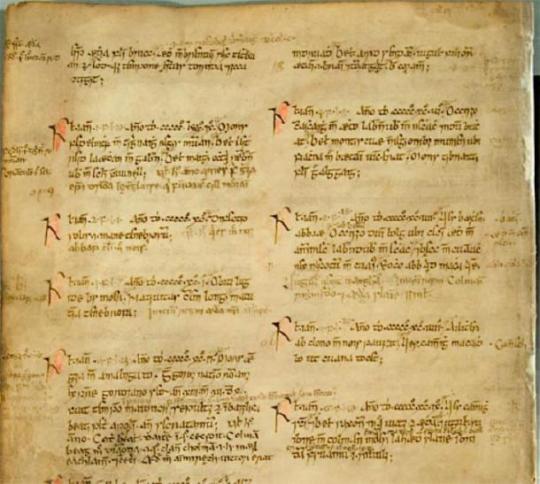
Spread the Word – Contents of the Manuscript
The Book of Kells consists of 340 sheets of fine vellum, which in turn totals 680 pages. It is comprised of the Four Gospels, and it is written in majuscule insular script, in yellow, red, purple, and black ink. The dimensions are 13 by 8.7 inches (330 by 220 millimeters), but these are the dimensions that resulted in a 19th century rebinding.

Interestingly, the Book of Kells seems to have never been finished. Several of the illuminations and decorations still remain only as outlines and were never filled and colored.
This ties in with the version that the manuscript’s completion was disturbed with the appearance of Viking raids. Either way, it is clear that this book was accomplished by a skilled team of monks in a scriptorium that was modern for its time, and that it most likely took them several years to accomplish.
It is written on a very fine vellum – aka animal skin or in this case the skin of a calf. It is thought that to produce the full Book of Kells, around 185 animals had to be killed to produce the vellum. Either way the quality is remarkable, although not all the pages are of same thickness – several are so fine that they are almost translucent.
The Book of Kells consists of preliminary writings and the Four Gospels – of Matthew, Luke, Mark, and John. The latter, Gospel of John, is incomplete, and goes only up to John 17:13 (And now come I to thee; and these things I speak in the world, that they might have my joy fulfilled in themselves.) The missing parts are generally attributed to the theft of the gold cover pages, which were torn off in the 10th century.
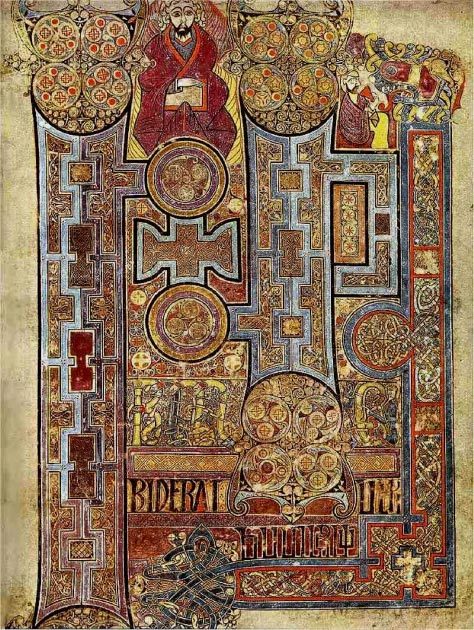
Of the preliminary writings, there are the Breves Causae (the Summaries of the Gospels), the Eusebian canons, and short biographies of the evangelists. All the writings are based from the Vulgate, a 4th century translation of the Bible into Latin. The Vulgate was completed by Saint Jerome in 384 AD.

The Book of Kells contains the symbols of the Four Evangelists (Clockwise from top left): a man (Matthew), a lion (Mark), an eagle (John), and an ox (Luke). (Magnus Manske / Public Domain )
As mentioned, there was a team of highly skilled scribes and artists from the abbey that worked on the book. All the big decorations were most likely produced by only three artists. There are subtle differences between each of the three, even though their names are unknown.
There were particular artists who did the major ornamental and interlaced knotwork designs such as the famous Chi Rho page. The stunning attention to detail and the mind dazzling intricacy of the woven lines is really amazing for the time period and is counted among the finest examples of Gaelic Celtic art.
The text was copied by four chief scribes. Slight differences can be observed through detailed studying of the writings, showing characteristic style shifts among the four.
It is observed that a particular scribe tended to repeat passages in order to fill up blank spaces on the page, as well as to use bright colors in the text itself. Another scribe did only the letters, avoiding decorations and leaving them to one of the artists.
Tedious Homework – Errors and Repetitions
An interesting glimpse into the trade network of the period can be seen from the many colors used in the Book of Kells. Most of these pigments had to be imported from abroad, often from quite far away, yet they still found their way to the small islands of Iona, Lindisfarne, and the Hebridean hermitages. The pigments were used for yellow, red, green, indigo, and blue.
Blue was made from woad, which was native to northern Europe, so that wasn’t such a problem to acquire. But the ochre for red and yellow, the verdigris green copper pigment, and lapis lazuli, all had to be imported from the Mediterranean. And in the case of ultramarine (lapis lazuli) it had to be acquired as far as Afghanistan.
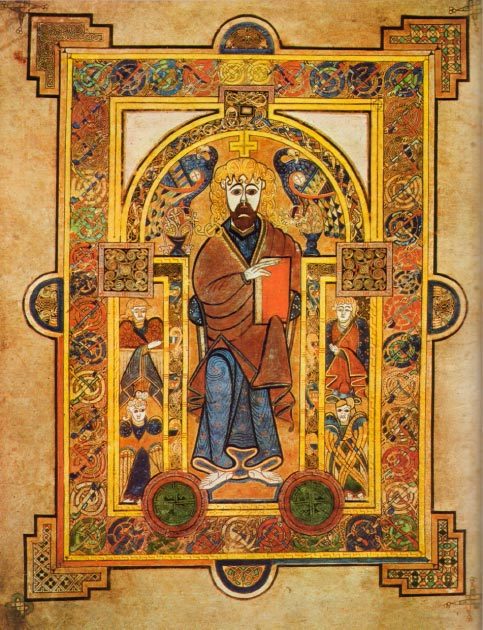
One surprising aspect of the Book of Kells is the seeming careless transcription, with numerous mistakes present throughout the manuscript. Granted, copying a manuscript takes a ton of concentration and dedicated effort, so mistakes can happen. Still, such a number of silly mistakes either tells us that the book had a more ceremonial use – not for daily use – or the Gaelic monks weren’t perfect masters of either the Latin language or insular script.
Words were skipped, pages repeated, and transcriptions wrong.
For example, the page 218 is a duplicate. It was clearly reproduced by mistake, but rather than discard it (it was a lot of hard work to produce even a single page) the monks chose to keep it in the book, nonetheless. The only thing that was done was the addition of numerous red crosses and red lines to indicate that the page should be ignored – as it was a mistake.
Also, there are plenty of errors in the text. A notable example is Matthew 10:34 (I came not to send peace, but a sword.) The original phrase in Latin should be: “Non veni pacem mittere, sed gladium.” But the scribe mixed gladium with gaudium, which means joy. Thus, the passage wrongly states: ”I came not to send peace, but joy.”
But in the end, the acceptance of such mistakes by the monks and the order tell us that it was really the aesthetics of the Book of Kells that were praised, rather than the written content itself. With almost all of the population at the time being illiterate, it was of no consequence that a word or two was wrongly written.
It was the grandiose look that had the purpose – to leave a lasting impression on the common folk, and to kindle belief in the hearts of the flock. And with the magnificent illustrations, with the mind boggling intricacy of the details, and the splendor of colors, we can safely assume that every common man of the time would be awestruck upon seeing the Book of Kells.
A Heritage to Last Centuries
Even though it is Christian in purpose and origin, the Book of Kells is still singlehandedly one of the most important insights into Irish and insular Gaelic art and culture. With numerous complex illustrations in this book, one certainly stands out. It is the page 34, with the full page illustration of the Chi Rho . Such an amazing level of detail, so many incredibly complex twists and interlaced designs, an abundance of La Tène Celtic art elements, bold colors, and endless depth, all tell us that the creation of even this single page could have taken many years.
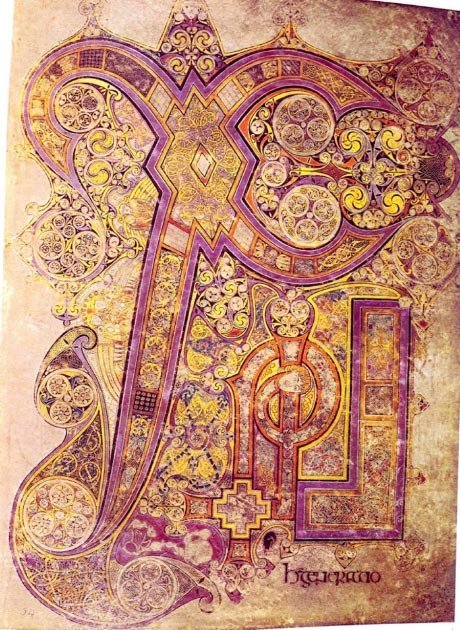
The Book of Kells contains the Chi Rho monogram. Chi and rho are the first two letters of the word Christ in Greek. (Soerfm / Public Domain )
And the whole of the Book of Kells was surely a product of much hard labor, dedication, and tedious transcription that was done by the monks. Those same monks who dedicated their lives to spiritual matters, and who so desperately yearned to secure their place in the imagined afterlife by carefully creating this immortal piece of Gaelic art.
12 notes
·
View notes
Photo

A horned figure on the Celtic Gundestrup Cauldron
104 notes
·
View notes
Text
Des concerts à Paris et alentour
Novembre
28. Anne-James Chaton – Auditorium|Cité de l'architecture (gratuit)
28. Boubakar Cissokho – Chair de poule (gratuit)
28. Adult. + KatzKab – Petit Bain
28. Borja Fames + Eloïse Decazes + Èlg – Instants chavirés (Montreuil)
28. Ensemble IRE joue "Nexus Entropy" d'Ulrich Krieger + Marc Baron + Lionel Marchetti (fest. Bruits blancs) – Anis gras (Arcueil)
29. SK/LR – Chair de poule (gratuit)
29. Émilie Pitoiset, Shantidas Riedacker & Matthieu Canaguier – Petite salle|Centre Pompidou (gratuit)
29. Esben & The Witch + Ingrina – Point FMR
29. Jessica Moss + Tomoe – Gambetta Club
29. Confusional Quartet + René Couteau + Tumulus + Samon Takahashi + Bernard Filipetti vs Ravi Shardja – Le Cirque électrique
29. Maud Geffray (dj) + Fishbach (dj) + Brigitte Fontaine + Musique chienne – Trabendo
29. CHDH + Mariachi + Lårs Akerlund & Sten Backman (fest. Bruits blancs) – Le Cube (Issy-lès-Moulineaux)
29. Rakta + Marée noire + Trashley – Instants chavirés (Montreuil)
29. Interpol + Nilüfer Yanya – Salle Pleyel ||COMPLET||
30. Mick Harvey + Brisa Roché – Petit Bain
30. Artus + Fleuves noirs + Hex – Le cirque électrique
30. Spit Mask + Poison Point + Lunacy + Some Ember + Offermose + Kaukolampi – La Station
30. Deeat Palace + Tamara Goukassova + Tryphème – L'International
30. Machine sauvage + Léon Denise (fest. Vision'R & Cookie Demoparty) – Folie numérique N5|Parc de La Villette
30. Trevor Jackson + Violent quand on aime – La Java
30. John Chatler + Samuel Sighicelli + Shapednoise (fest. Bruits blancs) – Anis gras (Arcueil)
Décembre
01. Dominique Petitgand (diff.) – Théâtre de Gennevilliers (gratuit)
01. Mamiedaragon + Jogging – Le Zorba (gratuit)
01. NAO (fest. Vision'R & Cookie Demoparty) – Folie numérique N5|Parc de La Villette
01. Nadia Ratsimandresy + Bruno Chevillon + Uriel Barthélémi + Marc Sens + Annabelle Playe (fest. Bruits blancs) – Anis gras (Arcueil)
01. Deux boules vanille + Jeff Mills + Molécule + Renart + Nicolas Horvath joue P. Glass, T. Riley et J. Adams + Ensemble Links : "Music for 18 Musicians" de S. Reich (fest. Marathon!) – La Gaîté lyrique ||COMPLET||
02. Beak> + Le Comte – Café de la danse ||COMPLET||
03. Pardans – Olympic café
03. Tanz Mein Herz + Dragon du Poitou + Mega Bass – La Java
03. Idles + John – Bataclan ||COMPLET||
05. Dick Annegard – BNF (gratuit)
05. Julia Holter – Petit Bain
05. Sudden Infant + Massicot – Centre culturel suisse
06. Harry Merry – Chair de poule (gratuit)
06. La Tène avec Jacques Puech, Louis Jacques, Guilhem Lacroux & Jérémie Sauvage – Centre culturel suisse
06. The KVB + M!R!M – Badaboum
07. Kink Gong – Médiathèque musicale (gratuit)
07. Antoine Chessex + Nina Garcia + Francisco Meirino – Centre culturel suisse
07. Heimat + Bordigaga + Bruno Billaudeau, Xavier Mussat & Black Sifichi (Semaine du bizarre) – Instants chavirés (Montreuil)
07. Nosfell – Espace 1789 (Saint-Ouen)
07. Aubadja + chdh (fest. Vision'R) – Le Générateur (Gentilly)
07. Shxcxchcxsh + W.LV.S + Wlderz – Rex Club
08. The Horrorist + Federico Amoroso – L'Officine
08. Jean Benoît Dunckel + NSDOS + CloZee + Kiddy Smile (Inasound fest.) – Palais Brongniart
08. Blawan + The Advent + AWB + Yogg & Pharaoh + Netsh – Concrete
08. Tim Tama + Gijensu + Makornik + K – Glazart
08. Père Ubu (Semaine du bizarre) – Théâtre Berthelot (Montreuil) ||COMPLET||
09. Panteros666 + Matt Black + Erol Alkan + Kiasmos (Inasound fest.) – Palais Brongniart
09. The Fleshtones – Supersonic
09/10. Moriarty – Cité de la musique|Philharmonie
11. Joanna + October Lieber – Badaboum
12. Nova Materia – La Maroquinerie
12. Le Réveil des tropiques + France + Helio Polar Thing – Petit Bain
12. Mange Ferraille + Boolvar + So-lo-lo – Le Cirque électrique
13. Qonicho B + Johann Mazé – Le Zorba (gratuit)
13. The Callas + Selofan + Hørd (fest. Magnétique Nord) – La Station
13. Villejuif Undergound + Bryan's Magic Tears + Free Love – La Bellevilloise
14. New Model Army – Trabendo
14. Carol Robinson, Bertrand Gauguet, Julia Eckhardt & Yannick Guedon : "Sequel to Occam Ocean" (2018) d’Éliane Radigue – Palais de Tokyo
14. Sida + Broken English Club + Toresch + Moderna + Wr2old + Shazzula (fest. Magnétique Nord) – La Station
14. Hangman's Chair + Jessica93 + Revok – Les Cuizines (Chelles)
14. Succhiamo + Air LQD + Rraouhhh + Christophe Clébard – Le Chinois (Montreuil)
14. Rebekah + Paula Temple + Anetha + Hannah b2b Charlene – Concrete
14. Mr Oizo – NF-34
15. Gaspar Claus – Cité de la musique|Philharmonie
15. Ata + Oliver Hafenbauer + Chinaski + Last Love Pilgrim + Kilian Paterson + Slyngshot + DJ Neewt (fest. Magnétique Nord) – La Station
15. Job Sifre + Fatma Pneumonia + X1000 + Spunoff (fest. Magnétique Nord) – La Station
15. AZF + Clouds + Aleksi Perälä + Barker – Rex Club
15. Derrick May + Helena Hauff + I Hate Models + Rrose + Noncompliant + Voiron + Galaxian + Sentimental Rave + Sama' + Amarou + Crystallmess – Concrete
15. Mount Kimbie + Marcel Dettman + Dixon + Rødhåd + Hot Chip + Rone + Roman Flügel + Lorenzo Senni + Lena Willikens + Epsilove... – Paris Event Center
16. Tomoko Sauvage – Lafayette Anticipations
18. Drab Majesty – Point FMR
18. Vox Low + Zombie Zombie (fest. Les Aventuriers) – Espace Gérard-Philipe (Fontenay-sous-Bois)
19. Belmont Witch + Zad Kokar + Petra Pied de biche – Instants chavirés (Montreuil)
21. Peter Van Hoesen + Clo d'or + Neel – Rex Club
21. Cleric + Jacidorex + Matrixxman + Parfait + SNTS – tba
22. Yan Wagner + Il est vilaine + Magnüm + Mayerling – La Maroquinerie
22. 2manydjs – NF-34
2019
Janvier
02. Les Hôpitaux + CIA débutante – Supersonic (gratuit)
09. Ayarcana b2b Ossian + Endlec + 1ndica – Rex Club
10. Jemek Jemowit + Infecticide + Cachette à branlette – L'International
11. The Choolers Division – La Station
12. Art & Technique + A_R_C_C + Bleno Die Wurstbrücke – Le Cirque électrique
18. Francis Dhomont (fest. Akousma) – MPAA Saint-Germain (gratuit sur résa)
19. Armando Balice + Ingrid Drese + Jérôme Noetinger + Loïse Bulot + Robert Hampson (fest. Akousma) – MPAA Saint-Germain (gratuit sur résa)
20. Catherine Bir + Raphaël Mouterde + Francisco Meirino + Roland Cahen + Yoko Higashi & Lionel Marchetti (fest. Akousma) – MPAA Saint-Germain (gratuit sur résa)
22. Emmanuelle Parrenin & Dominique Regref – La Ferme du Buisson (Noisiel)
24. Rouge Gorge – Le Chair de poule
25. La Secte du futur + Shiny Darkly – Supersonic
25. Léonie Pernet – Gaîté lyrique
26. Chloé – Elysée-Montmartre
29. Dominique a – Salle Pleyel
31. Deena Abdelwahed – Gaîté lyrique
Février
02. Tempers – Supersonic (gratuit)
02. The Residents – Gaîté lyrique
02. Shabazz Palaces + Dälek (fest. Sons d'hiver) – théâtre de la Cité internationale
06. Brendan Perry – Petit Bain
07. VNV Nation – Le Trabendo
09. The Ex : "Ethiopian Night" (fest. Sons d'hiver) – salle Jacques-Brel (Fontenay-sous-Bois)
10. Therapy? – La Maroquinerie
11. Massive Attack feat. Liz Fraser jouent « Mezzanine » – Zénith
16. Anthony Braxton + Dave Douglas & Bill Laswell (fest. Sons d'hiver) – théâtre Jacques-Carat (Cachan)
21. Mlada Fronta + Absolute Valentine + Neoslave – Petit Bain
21. Collection d'Arnell Andrea + Katzkab – Bus Palladium
22. Nils Frahm – Le Trianon ||COMPLET||
23. Nils Frahm – Le Trianon
Mars
02. Boy Harsher + Kontravoid – Badaboum
02. Lydia Lunch & Marc Hurtado jouent Alan Vega et Suicide – Silencio
07. Scratch Massive – Gaîté lyrique
10. James Chance & Die Contortions – Supersonic
12. Yann Tiersen – Salle Pleyel
20. Oomph! – La Machine
22. Delia Derbyshire (diff.) + Lettera 22 + Evil Moisture + Caterina Barbieri + Drew McDowall : "Coil's Time Machines" (fest. Présences électronique) – Studio 104|Maison de la Radio
22. The Young Gods – La Maroquinerie
23. Pierre Boeswillwald (diff.) + Max Eilbacher + Andrea Belfi + Sarah Davachi + William Basinski & Lawrence English (fest. Présences électronique) – Studio 104|Maison de la Radio
24. Warren Burt (diff.) + Mats Erlandsson + Okkyung Lee + Low Jack + BJ Nielsen (fest. Présences électronique) – Studio 104|Maison de la Radio
29. Perturbator – Le Trianon
30. Marc Almond – Le Trianon
Avril
05. Beirut – Le Grand Rex
08. The Specials – La Cigale
10. Daughters – Point FMR
14. Arnaud Rebotini joue la BO de "120 Battements par minute" – Cité de la musique|Philharmonie
17. Teenage Fan Club – Trabendo
17. Soap&Skin – Le Trianon
17. Apparat – Gaîté lyrique
21. The Parrots + Johnny Mafia + Halo Maud + Grand Blanc + Marietta + Robbing Millions + Oktober Lieber (fest. MOFO) – Mains d'oeuvre (Saint-Ouen)
22. Fontaines D.C. – Point FMR
22. Faire + Buvette + Oko Ebombo + Black Devil Disco Club + Fujiya & Miyagi + Rendez-Vous (fest. MOFO) – Mains d'oeuvre (Saint-Ouen)
23. The Luyas + Barbagallo + Human Teorema + Arnaud Rebotini + Aquaserge + Il est vilaine + Onze Onze (fest. MOFO) – Mains d'oeuvre (Saint-Ouen)
27. She Past Away – La Machine
27. Chloé : Lumières noires – Le 104
Mai
07. dEUS – La Cigale
10/11. Dead Can Dance – Grand Rex ||COMPLET||
11. Christina Vantzou + Eiko Ishibashi + Jan Jelinek + NPVR (Nik Void & Peter Rehberg) – Le 104
12. Massimo Toniutti + François Bayle – Le 104
17. Philip Glass : Études pour piano – Salle Pierre-Boulez|Philharmonie
18. Bruce Brubaker & Max Cooper : Glasstronica – Cité de la musique|Philharmonie
28. Alice in Chains + Black Rebel Motorcycle Club – Olympia
31. François Bonnet + Knud Viktor + Jim O'Rourke + Florian Hecker (fest. Akousma) – Studio 104|Maison de la Radio
Juin
01. Eryck Abecassis & Reinhold Friedl + Hilde Marie Holsen + Anthony Pateras + Lucy Railton (fest. Akousma) – Studio 104|Maison de la Radio
02. Bernard Parmegiani + Jean Schwarz (fest. Akousma) – Studio 104|Maison de la Radio
19. Stephen Malkmus & The Jicks – La Gaîté lyrique
26. Magma – Salle Pierre-Boulez|Philharmonie
Juillet
11. Masada + Sylvie Courvoisier & Mark Feldman + Mary Halvorson quartet + Craig Taborn + Trigger + Erik Friedlander & Mike Nicolas + John Medeski trio + Nova quartet + Gyan Riley & Julian Lage + Brian Marsella trio + Ikue Mori + Kris Davis + Peter Evans + Asmodeus : John Zorn's Marathon Bagatelles – Salle Pleyel
Août
23>25. The Cure (fest. Rock en scène) – parc de Saint-Cloud
Septembre
13. Rammstein – La Défense Arena (Nanterre) ||COMPLET||
en gras : les derniers ajouts / in bold: the last news
4 notes
·
View notes
Text

The Desborough Mirror. One of the finest examples of ‘Celtic’ La Tène art from late Iron Age Britain. The intricate, swirling decoration engraved on the back of this bronze mirror, highlights the sophisticated craftsmanship of pre-Roman Britain. 50 BC - AD 50. From Alison Fisk’s Twitter. G O R G E O U S!
0 notes
